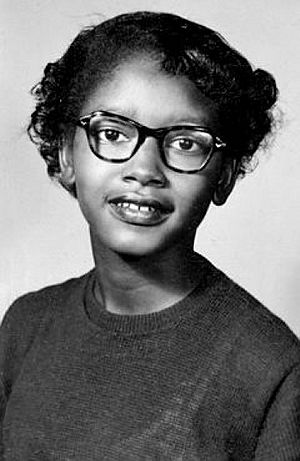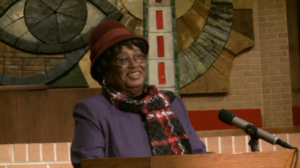Claudette Colvin facts for kids
Quick facts for kids
Claudette Colvin
|
|
|---|---|

Colvin in 1952, at age 13
|
|
| Born |
Claudette Austin
September 5, 1939 Montgomery, Alabama, U.S.
|
| Occupation | Civil rights activist, nurse aide |
| Years active | 1969–2004 (as nurse aide) |
| Era | Civil rights movement (1954–1968) |
| Known for | Arrested at the age of 15 in Montgomery, Alabama, for refusing to give up her seat to a white woman on a segregated bus, nine months before the similar Rosa Parks incident. |
| Children | 2 |
Claudette Colvin (born Claudette Austin; September 5, 1939) is an American civil rights activist and retired nurse aide. On March 2, 1955, when she was 15 years old, she was arrested in Montgomery, Alabama. She had refused to give up her seat to a white woman on a crowded, segregated bus. This happened nine months before a similar, more famous event involving Rosa Parks.
Colvin was one of four people who filed the first federal court case to challenge bus segregation in Montgomery. This case, called Browder v. Gayle, was filed on February 1, 1956. Colvin testified in court. On June 13, 1956, judges decided that laws requiring bus segregation in Alabama were against the United States Constitution. The case went to the United States Supreme Court, which agreed with the lower court's decision. This ruling helped end bus segregation.
For many years, leaders in Montgomery's black community did not talk much about Colvin's brave action. Colvin has said, "Young people think Rosa Parks just sat down on a bus and ended segregation, but that wasn't the case at all." Civil rights campaigners at the time chose not to highlight Colvin's case due to her personal situation. Rosa Parks later explained that they wanted to avoid giving the white press a reason to criticize the movement. In 2021, the record of her arrest was officially cleared by the court.
Contents
Claudette Colvin's Early Life
Claudette Colvin was born Claudette Austin in Montgomery, Alabama, on September 5, 1939. Her mother could not support her and her younger sister, Delphine. So, Claudette and Delphine were raised by their great-aunt and uncle, Mary Anne and Q. P. Colvin. They took the Colvin last name. The Colvins lived in Pine Level, a small town in Montgomery County. This was the same town where Rosa Parks grew up. When Claudette was eight, her family moved to King Hill, a black neighborhood in Montgomery.
In September 1952, Colvin started attending Booker T. Washington High School. She was a good student and joined the NAACP Youth Council. There, she became close with her mentor, Rosa Parks.
Standing Up on the Bus
In 1955, Colvin was a student at the segregated Booker T. Washington High School. She rode city buses to get to school because her family did not own a car. Most bus riders were African American, but they faced unfair rules about seating. Colvin was learning about the civil rights movement in school. On March 2, 1955, she was riding home from school. She sat in the section for black passengers.
Bus rules said that if the "white seats" in the front filled up, black passengers had to give up their seats for white people. If there were no free seats in the back, black passengers had to stand. When a white woman got on the bus and was left standing, the bus driver told Colvin and three other black women in her row to move to the back. The other three women moved. But another black woman, Ruth Hamilton, who was pregnant, sat next to Colvin.
The driver told both women to get up. Mrs. Hamilton said she would not because she had paid her fare. Colvin also refused to move. The driver then said he would call the police. Police arrived and arrested Colvin. She was forced off the bus and handcuffed. This happened nine months before Rosa Parks was arrested for the same reason. Colvin later said her mother told her to let Rosa Parks be the public face of the protest. Colvin did not get the same attention as Parks for several reasons. Civil Rights Movement leaders wanted to choose the "most appealing" protesters to be seen.
Why Claudette Refused to Move
When Colvin refused to move, she was thinking about a school paper she had written that day. It was about unfair rules that stopped black people from trying on clothes in department stores. She later said, "We couldn't try on clothes. You had to take a brown paper bag and draw a diagram of your foot... and take it to the store." She felt that if the white woman sat in the same row, it would mean they were equal.
Annie Larkins Price, a classmate, said, "She had been yelling, 'It's my constitutional right!'" Colvin recalled feeling like Harriet Tubman and Sojourner Truth were pushing her to stay in her seat. She shouted that her constitutional rights were being violated. Colvin said her action was "the first cry for justice, and a loud one."
Colvin was charged with disturbing the peace and violating segregation laws. Her lawyer was Fred Gray. She was found guilty in a juvenile court. When her case was appealed, the charges for disturbing the peace and violating segregation laws were dropped.
Challenging Segregation in Court
Claudette Colvin was one of five people who were part of the court case Browder v. Gayle. The others were Aurelia S. Browder, Susie McDonald, Mary Louise Smith, and Jeanetta Reese. Jeanetta Reese later left the case. This case was organized by civil rights attorney Fred Gray. It challenged the bus segregation laws in Montgomery, saying they were unconstitutional. During the court case, Colvin described her arrest. She said she kept saying, "This is my constitutional right... you have no right to do this."
Browder v. Gayle went through the courts. On June 5, 1956, a federal court ruled that Alabama's laws forcing bus segregation were unconstitutional. State officials appealed the case to the United States Supreme Court. On November 13, 1956, the Supreme Court agreed with the lower court's decision. A month later, on December 20, 1956, the Supreme Court ordered Montgomery and Alabama to end bus segregation forever. This ruling helped end the Montgomery bus boycott.
Life After Activism
Colvin had a son, Raymond, in March 1956. In 1958, Colvin moved from Montgomery to New York City. It was hard for her to find and keep work in Montgomery after being part of the court case that ended bus segregation. She felt many in her community saw her as a troublemaker.
In New York, Colvin lived with her older sister. In 1960, she had another son, Randy. In 1969, Claudette started working as a nurse's aide in a nursing home in Manhattan. She worked there for 35 years, retiring in 2004. Her son Randy is an accountant in Atlanta and has four children.
Legacy and Recognition
Colvin's action came before the famous Montgomery bus boycott of 1955. But she rarely shared her story after moving to New York City. Black organizations at the time believed that Rosa Parks would be a better person to lead a test case for integration. They felt Parks was an adult, had a job, and looked middle-class. They thought she had the maturity to handle being the center of attention.
Colvin was not the only woman whose role in the Civil Rights Movement was less known. In the South, most leaders were male ministers. This was partly because the NAACP wanted to present a certain image. It was also because women often feared losing their jobs, especially if they worked in public schools.
In 2005, Colvin told the Montgomery Advertiser that she would not change her decision to stay seated on the bus. She said, "I feel very, very proud of what I did." She added, "I do feel like what I did was a spark and it caught on." She also said, "Let the people know Rosa Parks was the right person for the boycott. But also let them know that the attorneys took four other women to the Supreme Court to challenge the law that led to the end of segregation."
On May 20, 2018, Congressman Joe Crowley honored Colvin for her lifetime of public service. He gave her a Congressional Certificate and an American flag.
Growing Recognition

Colvin has often said she is not angry about not getting more recognition. Instead, she is disappointed. She said it felt like "getting [her] Christmas in January rather than the 25th."
I don’t think there’s room for many more icons. I think that history only has room enough for certain—you know, how many icons can you choose? So, you know, I think you compare history, like—most historians say Columbus discovered America, and it was already populated. But they don’t say that Columbus discovered America; they should say, for the European people, that is, you know, their discovery of the new world.
Colvin and her family have worked to get her actions recognized. In 2016, they asked the Smithsonian Institution and its National Museum of African American History and Culture (NMAAHC) to give Colvin a more important mention in civil rights history. Colvin does not want Rosa Parks' section removed. Her family's goal is to make sure history is correct and includes Colvin's part. Colvin was not officially invited to the museum's opening in September 2016.
Colvin's sister, Gloria Laster, said, "All we want is the truth, why does history fail to get it right?" She added, "Had it not been for Claudette Colvin, Aurelia Browder, Susie McDonald, and Mary Louise Smith, there may not have been a Thurgood Marshall, a Martin Luther King or a Rosa Parks."
In 2000, Troy State University opened a Rosa Parks Museum in Montgomery. Roy White, who led the project, asked Colvin if she would appear in a video to tell her story. Colvin refused. She said, "They've already called it the Rosa Parks museum, so they've already made up their minds what the story is."
However, Colvin's role has gained some recognition. In the 2010s, a street was named after Colvin. In 2017, the Montgomery City Council passed a resolution honoring Colvin. March 2 was named Claudette Colvin Day in Montgomery. Mayor Todd Strange said Colvin was "an early foot soldier in our civil rights." Colvin could not attend the event due to health reasons.
In 2019, a statue of Rosa Parks was unveiled in Montgomery. Four granite markers were also unveiled near the statue to honor the four plaintiffs in Browder v. Gayle, including Colvin.
In 2021, Colvin asked a court in Montgomery County, Alabama, to clear her juvenile record. The District Attorney, Daryl Bailey, supported her request. He said her actions in March 1955 were "conscientious, not criminal; inspired, not illegal." The judge ordered her juvenile record to be cleared and destroyed in December 2021. The judge stated that Colvin's refusal had "been recognized as a courageous act."
In Culture
Former US Poet Laureate Rita Dove wrote a poem about Colvin called "Claudette Colvin Goes To Work." It was published in her 1999 book On the Bus with Rosa Parks. Folk singer John McCutcheon turned this poem into a song.
The young adult book Claudette Colvin: Twice Toward Justice, by Phillip Hoose, was published in 2009. It won the National Book Award for Young People's Literature.
The Little-Known Heroes: Claudette Colvin, a children's picture book by Kaushay and Spencer Ford, was published in 2021.
In 2022, a movie about Colvin called Spark was announced. It will be written by Niceole R. Levy and directed by Anthony Mackie.
See also
 In Spanish: Claudette Colvin para niños
In Spanish: Claudette Colvin para niños



